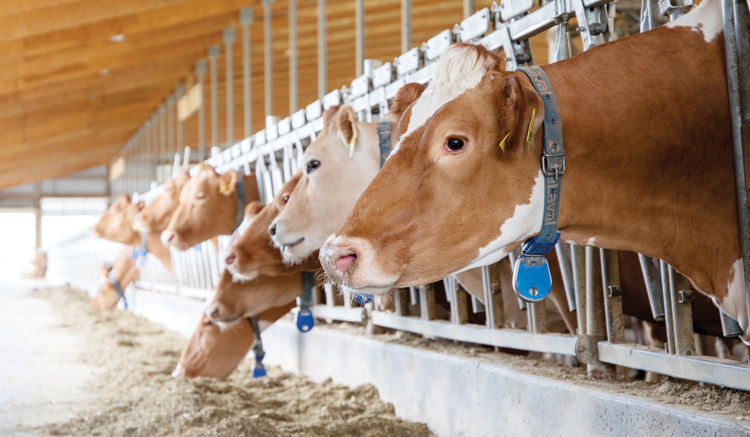The author is a dairy and agricultural writer based in Columbus, Ohio.

Events like World Dairy Expo can make a dairy producer’s heart beat a little faster at the sight of shiny new equipment and innovative technology to manage the herd. The choices often leave them pondering, “Is this something I should be using on my farm?”
The short answer is it depends.
Rather than just bringing new technology to the farm, think first about what you want to accomplish, advised Paul Dyk, a consultant with GPS Dairy Consulting LLC. He and his colleague, Andre Pereira, discussed approaches for adopting new technology in a recent episode of GPS DairyCAST.
Dyk and Pereira weighed in on a pair of widely available dairy technologies — activity monitors and feed software — and urged dairy producers to ask three important questions before implementing new technology:
- What do we expect it to do?
- Who will implement it?
- How will it pay for itself?
Activity monitors abound
Activity monitors are certainly attractive, noted Pereira. This technology can track movement, monitor rumination, and even pinpoint the exact location of every cow. It is advancing fast, and there are many new options. But the first conversation about this technology with producers revolves around return on investment. Can this technology pay for itself? Can it bring you peace of mind?
Answers to these questions are as unique as the farm itself. In a robotic system, for example, the geo-locator feature can be helpful for finding a cow on the fetch list or a heifer that is not coming to the robot for milking. “But will it be more useful than an employee who has been working at the farm for 20 years and knows every cow by name?” inquired Pereira.
Dyk agreed that the geo-locator has its merits, but it may not be the feature that brings value to every dairy. For example, in a rotary parlor, a sort-gate diverts problem cows as they leave the parlor. The crew is not likely to need to head to a pen of 300 animals to find a cow that prompted an alarm at 2 a.m. when that cow will be coming through the parlor again an hour later.
For some dairies, activity monitors may or may not be the most cost-effective solution. Though they can be a great fit to manage reproduction, a simple investment in tail chalk could be a smarter choice to tweak heat detection, noted Dyk. On the other hand, if you are looking to improve cow health or better monitor transition cows, activity monitors might be a wise investment.
The protocol for managing data and alerts should also be considered before you make the leap. In herds with 2,000 or more cows, it is impractical to respond to every notification. Running reports in the morning and afternoon is a wise approach to improve efficiency with this technology. Pereira recommended that producers run reports in the morning before feedbunk checks so the team can simultaneously be on the lookout for problem cows. Get in, get out, and be done, he advised.
Dyk encouraged producers to also consider the employees who will be doing the work. Sometimes we expect our employees to be as excited about technology as we are, but they may not be ready for it. Dyk said he has seen dairies lose great herdspeople because they brought in new technology but then the employees were reluctant to use it.
Evaluating feed software
Questions about feed software often coincide with the purchase of new equipment, like a mixer. Most ask, “Is this software better than what I have?”
Again, ask yourself how you will use the software, noted Pereira. Are you the type of person who looks at reports once a week to make sure cows are eating the right amount of dry matter? Or do you want more data? Maybe you look at reports daily to make sure load and drop accuracy are correct. Or maybe you have three or four feeders and want to make sure they are not over- or underfeeding the cows.
Some producers need easy-to-use software because they are not techies. Others want all their data in a cloud so it can be accessed by anyone anywhere. Some people are data geeks who want all the bells and whistles and every report possible. Every program has its pluses and minuses, so do your homework.
Another important consideration is the software’s ability to interact with the truck scale. Several legacy software programs do a great job with that task and have been doing it for a long time, the speakers noted.
Dyk recommended using caution when moving to a new technology. Make sure you are ready for the switch and the glitches that may follow. Some producers encounter one problem and then toss the whole program. Others can tolerate issues because they want to be on the leading edge of software technology.
Be sure you have someone on the dairy who is a master at using the software or a consultant who is, noted Dyk. Recently, he was on a dairy that was doing a great job with load accuracy and mixing protocol but struggled with the timing of the first feeding. Dyk discussed with them how to measure that and set up a report on the feeding program they already had. They just needed a little help from someone who understood how to use the software.
Today it is almost a necessity to have some kind of software to manage the feeding program, Dyk said. By investing $2,000 to $2,500, plus a monthly subscription fee of about 10 cents per head per month, a dairy should be able to set up a decent program, remarked Dyk. That investment can usually be recouped rather quicky.
The data from the feed software is also a great way to educate employees who may be doing a good job but need a refresher on doing their jobs even better. It may also be a useful tool for developing employee bonus programs.
Evolving technology
In the next couple of years, producers may be using more vision-based technology, according to Pereira. This technology is interesting because all you need is a camera. It’s not complicated, and it is being developed quickly, he shared.
Dyk is equally enthused about the possibilities of vision-based technology. Time-lapse cameras and their software and algorithms will soon let producers know how often and when feed is being pushed up, how long and when cows are without feed, and how much feed is left in the bunk.
New technology is continually being developed for the dairy industry. But before you are wooed by the latest and greatest, make sure it is a fit by asking these key questions: Who will be responsible, what do you want it to do, why do you want it, and will it provide a return?
For our 1,000+ Producers
Welcome to this new section in Hoard’s Dairyman, tailored specifically to you. Here we will provide content focused on the unique requirements and challenges found on operations milking more than 1,000 cows.
NOVEMBER 2023











